Posted: June 17th, 2014 | Author: Nathan | Filed under: field recording

It’s been an inordinately windy spring, even for the infamously windy San Francisco area. A previous post captured the sound of my fence swaying in heavy winds, and recently I discovered that my garage door not only creaks and groans in heavy winds, parts of it start vibrating.
So, into the garage with my MKH 50 I went…this high-pitched hiss in the background are leaves on a camphor tree just on the other side of the door. (I freely admit that while I was using a mid-side pair during recording and, ummm, well…I only had one track on my Sound Devices 702 armed to record. Sounded great in mid-side, but ya know what? You get to hear it in glittering, stunning mono!)
[soundcloud url=”https://api.soundcloud.com/tracks/152211065″ params=”color=ff5500&auto_play=false&hide_related=false&show_artwork=false&show_comments=true&show_user=true&show_reposts=false” width=”100%” height=”166″ iframe=”true” /]
| No Comments »
Posted: June 10th, 2014 | Author: Nathan | Filed under: gear
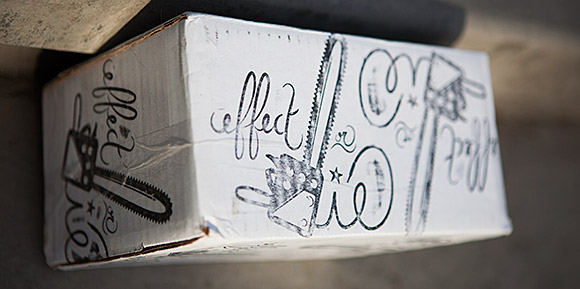
I’ve been rekindling my relationship with outboard sound devices…the tactility, oddness, instability, and organic nature sometimes either can’t be reproduced by a plugin, or no self-respecting coder would choose to emulate such strange circuits, so virtual equivalents don’t exist. When buying such devices, sure, we all check online for demo videos and the like…but many of these devices are deep. Even testing one for an hour in a shop won’t really unveil its true potential…if the shop even has it in stock, given how the best sonic manglers are made by fiercely independent makers. And then what? You’re really going to bring a laptop to a guitar shop to test a Kontakt patch through a fuzzbox? Or your field recording of a dawn chorus through a delay pedal?
Remember, too, that some film sound design has been done using effect pedals, like (the great-sounding but otherwise forgettable)Â Terminator: Salvation.
This is where rentals come in handy. My recent searches for strange effect pedals led me to discover Mike Galen’s company, Effect or Die. After having purchased a couple of pedals, he pointed out that they have an effects rental program, and invited me to give it a try. I took him up on his offer, and took the opportunity to do some research into effect pedal rentals.What follows is a result of my trial, and my research into renting such equipment. To be clear and transparent: Effect or Die provided me with a free rental period in order to test the service.
Read the rest of this entry »
| 1 Comment »
Posted: June 3rd, 2014 | Author: Nathan | Filed under: field recording, found sound objects

Contact mics are bloomin’ fun.
They say that wind in the San Francisco Bay Area doesn’t blow, it sucks. Actually, that’s physically accurate.
When California’s Central Valley heats up, the Sierra Nevada mountain range prevents the air from moving east, so it goes straight up. The cool, heavy air from the western coast then rushes in to fill the gap. This is what causes San Francisco’s famed summer winds and fog, creating summers that feel colder than winters.
Depending on what you’re trying to record, this can be a blessing or a curse. When I saw part of my fence moving about in 15-20 knot winds, I figured something interesting was happening. I could hear some subtle creaking, but if my ears were hearing it, I figured more was going on beneath the surface.
Windy days, of course, are great times to pull out the contact microphones. (Coincidentally, Tim Prebble just announced his second contact microphone sound library at the time of this writing.) No windscreens, no infrasound distortion, nothing. When I placed my contact mic on a fencepost, I got not only wood creaks, but the strain of metal wires tied into the fence to promote upwards growth of roses and vines. This added a metallic overtone that’s quite interesting.
It feels evocative of the strains and groans of a ship heaving at sea, or a castle gate straining under the weight of many warriors or beasts of war (recorded as always at 192khz, this kind of material sounds great pitch shifted -2 octaves). It’s been nice to get back to the world of contact microphones! Posted with no processing whatsoever, so you can actually hear some nearby windchimes in the background if you listen carefully, whose vibrations must have been picked up by the planks in the fence.
[soundcloud url=”https://api.soundcloud.com/tracks/148088989?secret_token=s-kN3PE” params=”color=ff5500&auto_play=false&hide_related=false&show_artwork=false” width=”100%” height=”166″ iframe=”true” /]
| 1 Comment »
Posted: May 6th, 2014 | Author: Nathan | Filed under: gear, music, sound design, synthesis
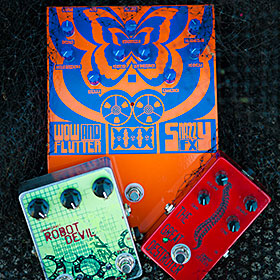
Sometimes sound design requires thinking inside of multiple boxes.
I’ve developed a small collection of handmade and boutique electronic effects and instruments over the years, like the Grendel Drone Commander, Lite2 Sound PX, and many more (perhaps the subject of another post). Longtime readers may recall that I just love supporting independent makers and small cottage industries: That’s where all the weird, truly innovative stuff happens, and I (like many of you, dear readers) am more interested in cool sound design possibilities than straight-up distorted guitarrrrrrrr sounds.
Beyond this, I’ve also been expanding my collection of effects pedals. My latest three are definitely the weirdest: The Great Destroyer and Robot Devil from Dwarfcraft Devices, and the Wow & Flutter from Snazzy FX.
Read the rest of this entry »
Tags: effect pedal, sci-fi, sound design, sound effects | No Comments »
Posted: April 25th, 2014 | Author: Nathan | Filed under: field recording, found sound objects
This post doesn’t have a whole lot of details around it, but the sound is neat.
I don’t remember the hotel. Was it the crappy motel in Monterey? The mildewed joint in Fort Bragg? Something more upscale on a work trip? I really don’t recall. But I remember the showerhead.
There was an aerator on the showerhead that, when the water wasn’t quite all the way off, made the most interesting sound as it sputtered out small air pockets in between drops. It sounded purely electrical and nothing like water at all. Check it out.
[soundcloud url=”https://api.soundcloud.com/tracks/140293893″ params=”color=ff5500&auto_play=false&hide_related=false&show_artwork=false” width=”100%” height=”166″ iframe=”true” /]
Tags: field recording, noise, urban | No Comments »
Posted: April 16th, 2014 | Author: Nathan | Filed under: field recording, nature recording
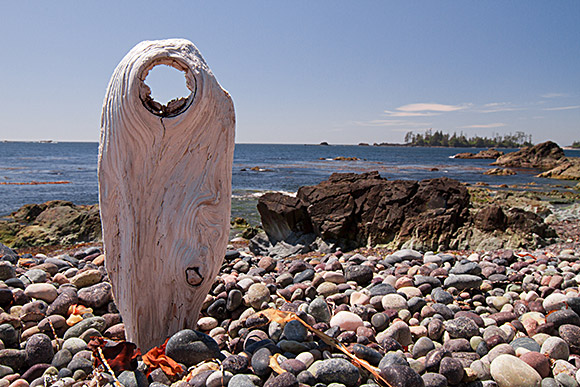
The view west to the Pacific Ocean from Catala Island, British Colombia, Canada.
During my 2013 kayak-camping expedition on the west coast of Vancouver Island, I spent a day by myself photographing and field recording Catala Island. You know you’re in a remote area when you refer to Vancouver Island as “the mainland.”
I found myself on a beach away from the direct Pacific swell, with a nice mix of pebbles and cobbles that made a wonderful rainstick-like tone when the gentle waves receded. (Of course, I’ve posted on recording waves before.)
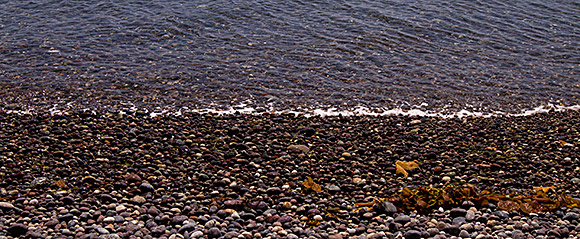
Cobble cobble cobble.
But as isolated as I was, man made sounds still managed to intrude. A lonely acoustic buoy in the distance bleated like a seasick cow on every incoming swell. You may be able to hear this in the background of this recording, faintly, although an aggressive 130Hz high pass filter helped remove the worst of it. Luckily this also removed the distant roar of the sea, actually helping to focus the sound on the small waves that really didn’t have much low-end to them at all.
Many dozens of miles from any road, on an island off another island off the main continent, the sounds of man still pervade. Or perhaps invade.
[soundcloud url=”https://api.soundcloud.com/tracks/140290561″ params=”color=ff5500&auto_play=false&hide_related=false&show_artwork=false” width=”100%” height=”166″ iframe=”true” /]
Tags: ambience, field recording, water | No Comments »
Posted: April 10th, 2014 | Author: Nathan | Filed under: field recording

The MV Uchuck III, passenger vessel and freigher on the west coast of Vancouver island. Kayak for scale.
One of the many reasons this site experienced an almost 1-year hiatus was a self-supported 2-week kayak expedition (check out the video of this amazing trip) on the northwest coast of Vancouver Island. The island is so riddled with deep networks of inlets that it’s actually quite hard to actually get to the exposed west coast. So, at the tiny logging town of Gold River, BC, we put our kayaks on the MV Uchuck III to get motored out to the coast.
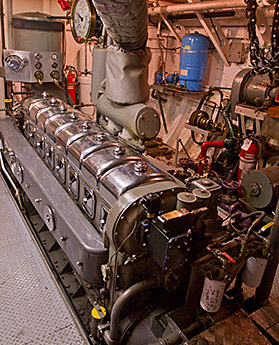
The MV Uchuck III engine room, starboard engine.
The Uchuck III is a lifeline for those that live on the edge of the world, where no roads exist and all travel must be by boat. The Uchuck III brings mail, deliveries, empty dumpsters, groceries, supplies, fish farm provisions, passengers and kayakers from Gold River out to Kyuquot, where we started our trip. It plays a vital role in this extremely remote region, and many generations of skippers and engineers have plied this route. The boat is so storied that there’s even a book about it and its predecessors.
The Uchuck III is a heavily modified World War II minesweeper. The inner double hull and stabilizers were removed to make room for a cargo hold, a crane was added, and the pilot house was moved astern. Its two propellers are powered by one straight-eight diesel engine apiece (a more cranky and surly version of the MV Tutoko, which I rode and recorded in the inlets of New Zealand’s Fiordland), and the skipper can’t control the engines from the pilot house: An actual telegraph is used to relay coded bell rings to the engineer below to take certain actions and “shift gears.” When this thing breaks down, parts need to be machined in Vancouver, from the original construction plans kept aboard.
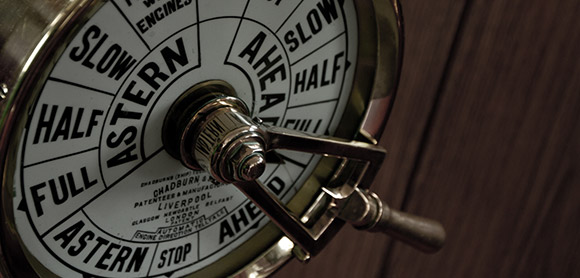
The engine telegraph unit.
Because we were just passing through, essentially, I didn’t get a chance to record too much material, but this post contains some of the perspectives I captured of the ship’s engines and cargo crane. Being a kayak expedition, I only had room for my Sony PCM-D50 recorder, which sucked for nature recording while kayaking…but it was more than sufficient for the loud pounding of the Uchuck III’s twin diesel engines.
[soundcloud url=”https://api.soundcloud.com/tracks/140290347″ params=”color=ff5500&auto_play=false&hide_related=false&show_artwork=false” width=”100%” height=”166″ iframe=”true” /]
Tags: engine, field recording, industrial, machine, mechanical, vehicle, water | 2 Comments »
Posted: April 2nd, 2014 | Author: Nathan | Filed under: field recording, gear, sound design
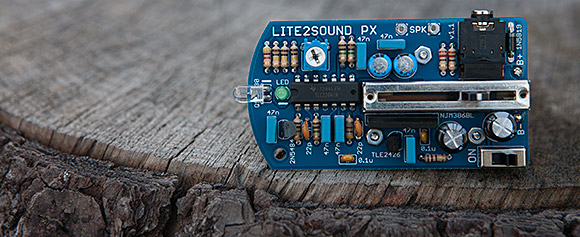
Rare Waves’ Lite2Sound PX, by Eric Archer: A photonic microphone!
I’ve previously written about the heavily-built, wickedly cool Grendel Drone Commander synth from Eric Archer. I check his site, Rare Waves, from time to time for new handmade electronic toys, and I was really intrigued by his newer Lite2Sound PX unit. This small device, in Eric’s words, “extracts audio from ambient light.” It’s a photodiode amplifier. Or a photosensitive microphone. Point it at light, it makes sound. It runs off a 9-volt battery, has a volume control, and a headphone jack. Simple, exciting, and a whole new world of sonic insanity. You can buy them as kits or, as I did, fully assembled.
Sounds pretty straightforward. If you just point it at bright, broad light sources, it’s kind of disappointing. It’s when you start listening to artificial lights in otherwise dim environments that some serious magic starts to happen. My experiments were conducted in and around high tech computer equipment, running an 1/8″ mini jack from the headphone output into my Sony PCM -D50 recorder.
Lights inside of PCs, modulated by fans…and further modulated by speaker grills as I passed the Lite2Sound from side to side. Ethernet network activity lights. Server disk access indicator lights. A close up of the power button of an XBox 360 while booting up. Pulsing lights of devices in standby mode. Halogen lamps behind spinning desk fans.
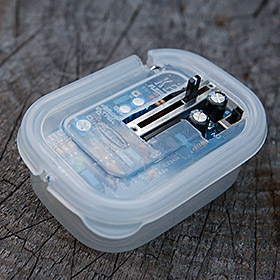
Lightly armored for future fieldwork!
The resulting sounds were astounding in their range: Static, glitches, distorted synth pads, pure sinewave tones, sawtooth-like tones, and much more. You can’t control it, really. It’s a tool of discovery, and its very nature encourages constant experimentation. It was so small and so perfectly complemented a handheld field recorder, I just wanted to take it everywhere and point it at everything! It imparted the same joy as when you start recording with contact microphones, or hydrophones: A new way to listen to the world around you. The more I used the Lite2Sound, I put it in a small plastic container (hacked with an XActo knife for access to controls and the headphone jack) in order to keep the components better protected.
Lite2Sound is a pretty narrowly-focused device and how useful it is to you depends on your taste for the unpredictable. Me, I adore this thing. Hell, I bought two (for future stereo photo-phonic insanity). It encourages constant experimentation, weighs nothing, and I can see using its output in both sound design and musical contexts. Eric Archer nails it again with an odd concept and a rock-solid, focused execution that results in a toy that just begs to be played with.
[soundcloud url=”https://api.soundcloud.com/tracks/139812053″ params=”color=ff5500&auto_play=false&hide_related=false&show_artwork=false” width=”100%” height=”166″ iframe=”true” /]
Tags: audio equipment, digital audio, field recording, sound design, sound effects | 3 Comments »
Posted: March 25th, 2014 | Author: Nathan | Filed under: music, video/motion
We all get caught between having creative ideas, yet having extremely limited available time to explore them. To explore some personal creative ideas during an extremely busy time, I decided to give myself a challenge: Create a shortform video in 36 hours, inclusive of shooting, post, and sound.
It wouldn’t be the best thing ever, but it’d be a Thing. A Thing would be done…or as done as I could make it. The goal wasn’t to create the best thing ever…it was to make something. Period. And the time constraint would force concision, hard choices, and provide the constraints needed to be creative.
This resulted in The Barn. If you’d like to watch this short video, I’d prefer you watch this full screen. I’ll wait right here.
Given the focus of this blog, I suppose that I should speak to the music in a little more detail. I conceived, shot, and did a rough edit of the video in about a day. I slept on it, and composed the music the following morning in one session. The soundtrack is influenced by what I’ve been listening to recently: Ben Frost, Kammarheit, Erik Skodvin, Elegi, Stefan Németh, Paul Corley, and others. The music started with a sampler patch I created based on me playing my guitar with a cello bow, and some guitar plucks prepared with small magnets. Samples included wood floor creaks and static bursts that I had recorded or generated over the past year. It was created in Logic Pro 9. (The description on Vimeo addresses more about visuals for those that are interested.)
Could the music be better? More dynamic? More varied? Sure, yes, on all fronts, with no doubt. But this was an exercise in reaching done, a battle against hoping to maybe-sorta start something, and actually making something, warts and all. As they say, “Better can be the enemy of done.”
There are a bajillion things I’d like to change, improve, and alter. But in 36 hours – including decent sleep – that’s not important. The goal was to express an idea with time as the primary constraint. And the goal isn’t to continue to obsess and tweak this project: It’s done. Now it’s time for the next Thing.
I learned a lot from this small project, and will definitely do more 36-hour projects in the future. I relish constraints, even if they are arbitrary: They focus the mind like nothing else, and soothe the Blank Canvas Problem.
I welcome any thoughts, especially on the value of constraints, in the comments below. Thanks for watching and listening. I’ll return to more typical posts on field design and sound recording in the coming weeks.
Tags: composition, creativity, creepy, music 2014, video | 5 Comments »
Posted: March 18th, 2014 | Author: Nathan | Filed under: news

With blackjack. And hookers. #futurama
The last post on this website was May, 2013. Almost a year ago.
Well, time to break the silence. It’s been a very busy and intense year, filled with both tribulations and triumphs, which is why Noise Jockey’s been on a sabbatical. But enough lollygagging. It’s time to get back to business.
Why now, after all this time? Maybe it’s the fact that some studio upgrades have me looking at audio anew. Maybe it’s because this week is the Game Developer Conference here in San Francisco, and my new office is only a couple of blocks away. Maybe it’s because I finally saw All Is Lost and played The Last of Us, both stunning artistic statements with some of the best sound work I’ve heard in a long, long time. Maybe it’s because I’ve been consuming gigabytes of new tunes that are changing how I look at music composition, genre, and sonic palettes. Maybe it’s just because all of you in the online sound community are good people and I’ve missed you all.
The audio fires are back in my belly. There are a bevy of new audio posts that are cued up and ready to roll. Good times ahead. I look forward to re-engaging with old readers, and starting conversations with new ones. So: I (re)welcome you back to Noise Jockey.
More very, very soon. Stay tuned.
| 4 Comments »











